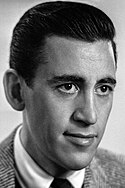J.D. Salinger Quote
A stunning glimpse of Buddy, at a later date by innumerable years, quite bereft of my dubious, loving company, writing about this very party on a very large, jet-black, very moving, gorgeous typewriter. He is smoking a cigarette, occasionally clasping his hands and placing them on the top of his head in a thoughtful, exhausted manner. His hair is gray; he is older than you are now, Les! The veins in his hands are slightly prominent in the glimpse, so I have not mentioned the matter to him at all, partially considering his youthful prejudice against veins showing in poor adults’ hands. So it goes. You would think this particular glimpse would pierce the casual witness’s heart to the quick, disabling him utterly, so that he could not bring himself to discuss the glimpse in the least with his beloved, broadminded family. This is not exactly the case; it mostly makes me take an exceedingly deep breath as a simple, brisk measure against getting dizzy. It is his room that pierces me more than anything else. It is all his youthful dreams realized to the full! It has one of those beautiful windows in the ceiling that he has always, to my absolute knowledge, fervently admired from a splendid reader’s distance! All round about him, in addition, are exquisite shelves to hold his books, equipment, tablets, sharp pencils, ebony, costly typewriter, and other stirring, personal effects. Oh, my God, he will be overjoyed when he sees that room, mark my words! It is one of the most smiling, comforting glimpses of my entire life and quite possibly with the least strings attached. In a reckless manner of speaking, I would far from object if that were practically the last glimpse of my life.
A stunning glimpse of Buddy, at a later date by innumerable years, quite bereft of my dubious, loving company, writing about this very party on a very large, jet-black, very moving, gorgeous typewriter. He is smoking a cigarette, occasionally clasping his hands and placing them on the top of his head in a thoughtful, exhausted manner. His hair is gray; he is older than you are now, Les! The veins in his hands are slightly prominent in the glimpse, so I have not mentioned the matter to him at all, partially considering his youthful prejudice against veins showing in poor adults’ hands. So it goes. You would think this particular glimpse would pierce the casual witness’s heart to the quick, disabling him utterly, so that he could not bring himself to discuss the glimpse in the least with his beloved, broadminded family. This is not exactly the case; it mostly makes me take an exceedingly deep breath as a simple, brisk measure against getting dizzy. It is his room that pierces me more than anything else. It is all his youthful dreams realized to the full! It has one of those beautiful windows in the ceiling that he has always, to my absolute knowledge, fervently admired from a splendid reader’s distance! All round about him, in addition, are exquisite shelves to hold his books, equipment, tablets, sharp pencils, ebony, costly typewriter, and other stirring, personal effects. Oh, my God, he will be overjoyed when he sees that room, mark my words! It is one of the most smiling, comforting glimpses of my entire life and quite possibly with the least strings attached. In a reckless manner of speaking, I would far from object if that were practically the last glimpse of my life.
Related Quotes
About J.D. Salinger
The Catcher in the Rye (1951) was an immediate popular success; Salinger's depiction of adolescent alienation and loss of innocence was influential, especially among adolescent readers. The novel was widely read and controversial, and its success led to public attention and scrutiny. Salinger became reclusive, publishing less frequently. He followed Catcher with a short story collection, Nine Stories (1953); Franny and Zooey (1961), a volume containing a novella and a short story; and a volume containing two novellas, Raise High the Roof Beam, Carpenters and Seymour: An Introduction (1963). Salinger's last published work, the novella Hapworth 16, 1924, appeared in The New Yorker on June 19, 1965.
Afterward, Salinger struggled with unwanted attention, including a legal battle in the 1980s with biographer Ian Hamilton and the release in the late 1990s of memoirs written by two people close to him: Joyce Maynard, an ex-lover; and his daughter, Margaret Salinger.
